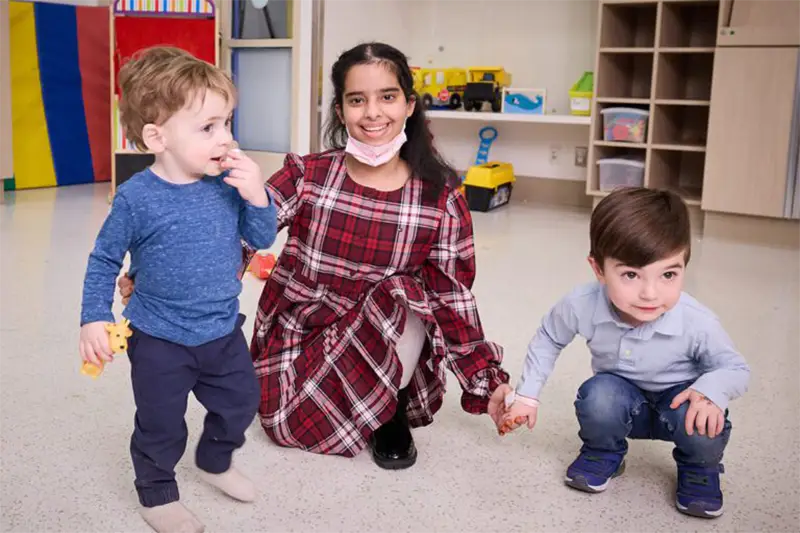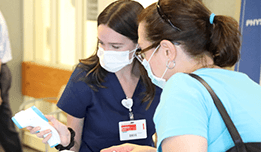In July 2024, over a span of 24 hours, a multidisciplinary transplant team at NewYork-Presbyterian Morgan Stanley Children’s Hospital of Children’s Hospital of New York became one of the first in the U.S. to perform a split-root domino partial heart transplant — a series of surgeries that enabled the young recipient of a deceased donor heart to donate her living valves to two other pediatric patients with congenital heart conditions.
The team was led by pediatric cardiothoracic surgeons Andrew Goldstone, M.D., Ph.D., and David Kalfa, M.D., Ph.D., who, the year prior, had performed the first-ever domino partial heart transplant in infants, in which one young patient who received a full heart transplant was able to donate her healthy valves to another infant. Since then, the surgeons have performed several more domino procedures, which positioned them well to perform the split-root domino.
NewYork-Presbyterian has one of the highest heart transplant volumes in the nation and is a top heart transplant program for pediatric patients, making it uniquely equipped to perform these types of complex cardiac surgeries. “It comes down to a culture of determination, a culture of innovation, and a culture of teamwork,” says Dr. Goldstone, surgical director of heart transplant and mechanical circulatory support and pediatric heart valve transplantation at NewYork-Presbyterian and Columbia. “Everyone here is dedicated to our patients and trying to do what we feel is best for them, their families, and their goals of care.”
“There is absolutely nothing that can be more rewarding than helping three patients at once,” says Dr. Kalfa, director of the Pediatric Heart Valve Center and surgical director for the Initiative for Pediatric Cardiac Innovation at NewYork-Presbyterian and Columbia. “Having such an impact on the life of children is magical to me.”

Dr. Andrew Goldstone (left) and Dr. David Kalfa led the teams that performed the series of surgeries that made up the split-root domino partial heart transplant.
The Opportunity to Save Three Lives
Living allogenic heart valve transplantation, also known as partial heart transplantation, fills a hole in care for pediatric patients with valve disease, who have few options for valve replacement. The most common solutions are cryopreserved homografts from deceased human donors; xenografts from cows and pigs, which can deteriorate quickly in children; and mechanical valves made of plastic and carbon, which require anticoagulation therapy due to the risk of clot formation. All three of these options lack the ability to grow with patients, which would mean invasive future surgeries for these children, explains Dr. Kalfa.
Domino transplants are one of the few options that allow for the donation of living valves, which grow and offer the potential for self-repair. Previous domino procedures have, thus far, benefited two patients at once; the split-root domino expands access to life-saving care by helping three patients at a time.
The pieces for performing the split-root domino at NewYork-Presbyterian Morgan Stanley Children’s Hospital of Children’s Hospital of New York came together during the evening of July 24, when Dr. Kalfa accepted a donor heart for 10-year-old patient Hend, who was diagnosed with dilated cardiomyopathy with significant mitral valve regurgitation.
Making sure that these valves were the right valves for the right children was extremely important. We are assessing the valves in terms of function; we don't want any leakage or obstruction.
— Dr. David Kalfa
Seven weeks prior, Dr. Goldstone had implanted a ventricular assist device in Hend to take over the circulation for her heart. “When she came to us, the weakness in her heart muscle was so profound that her heart couldn't pump enough blood to maintain adequate function of all of her other organs,” says Dr. Goldstone. Her valves, however, were healthy, so the transplant team created an internal list of patients in need of valves, tracking the required sizes and possible donors in the event of a potential domino situation.
“Hend was a great potential donor because her semilunar valves, namely the aortic and the pulmonary valves, worked quite well and were functioning normally,” Dr. Goldstone says. “Just because you’re older doesn't mean that your valves are necessarily bigger. And some of the disease processes that lead to patients needing valves can cause their valves to become stretched out. This allows us to implant valves from older children that, while not necessarily the right size for another child their age, is the right size for the heart and anatomy of a younger child with valve disease.”
They found Hend’s valves were the perfect match for two younger patients: 2-year-old Teddy, a patient of Dr. Kalfa’s who was diagnosed with aortic stenosis at 2 months old and needed a new aortic valve; and 18-month-old John, a patient of Dr. Goldstone’s born with truncus arteriosus who needed a new pulmonary valve.
“Making sure that these valves were the right valves for the right children was extremely important,” says Dr. Kalfa. “We are assessing the valves in terms of function; we don't want any leakage or obstruction. And we’re assessing the match of the diameter between the donor and two recipients. All of this is part of the selection to make sure the patients really benefit from this procedure.”
Working Against Time
Before the procedure, the patients had been speaking with surgical team members as well as members of the medical team, led by Marc Richmond, M.D., M.S., pediatric cardiologist and director of pediatric advanced cardiac care and transplantation at NewYork-Presbyterian and Columbia, to discuss the pros and cons of a split-root domino valve transplant, should the opportunity arise.
Once Dr. Kalfa accepted the offer for Hend’s donor heart, the care team — including pediatric cardiothoracic surgeons, anesthesiologists, perfusionists, surgical assistants, nurses, heart failure clinicians, ICU staff, and trainees — had roughly 12 hours to alert the patients’ families and coordinate the logistics.
“We needed to coordinate three transplant procedures in succession and simultaneously to minimize the ischemic time of the valves, and also to try to optimize how efficiently we could do them,” Dr. Kalfa says.
Around 8 a.m. on July 25, Dr. Kalfa, Dr. Goldstone and their teams readied Hend and John in adjacent operating rooms. Dr. Kalfa would do Hend’s heart transplant in one room, where he would also harvest the pulmonary valve from the explanted heart. Dr. Kalfa had to work quickly to transfer the first valve to Dr. Goldstone with as little ischemic time as possible.
To get a child through heart surgery requires a tremendous number of people. And they all have to work together well for this shared common goal of doing what's right by the patient.
— Dr. Andrew Goldstone
In the next room, Dr. Goldstone replaced John's cadaveric pulmonary valve with the living pulmonary valve, a surgery that took about six hours. He also removed a stent that was in John’s pulmonary artery.
After Hend’s heart transplant, which took around eight hours, Dr. Kalfa returned to the operating room for Teddy’s aortic valve replacement, where he ran into a complication: the donated aortic valve had an abnormal coronary artery, which required Dr. Kalfa to do a coronary unroofing, a surgical treatment to address the artery originating from the aorta in an abnormal position. “You encounter these types of surprise situations in cardiac surgery sometimes, which requires you to adapt and change your plan,” Dr. Kalfa says. Teddy’s aortic valve replacement concluded around 4 a.m.

Before and after echocardiography for Teddy, whose aortic stenosis caused both obstruction and aortic valve regurgitation. In the before imaging (left), the yellow marks the regurgitative path caused by the malformation of his valve. After receiving the living aortic valve, Teddy’s obstruction and regurgitation was resolved (right).
The surgeries went smoothly otherwise, with uneventful post-operative courses for each patient. John and Teddy were discharged nine days later, and Hend left the hospital nearly three weeks after her transplant. “The three patients are doing remarkably well, which is extremely rewarding,” Dr. Kalfa says.
“To get a child through heart surgery requires a tremendous number of people. And they all have to work together well for this shared common goal of doing what's right by the patient,” adds Dr. Goldstone.
Pushing the Boundaries of Valvular Disease Treatment
The NewYork-Presbyterian and Columbia pediatric heart failure and transplant teams see the success of their first split-root domino as progress toward putting innovative solutions for valve disease into practice to help as many children as possible.
One of the challenges they want to help alleviate is finding more opportunities for living heart valve donation. From an allocation and regulatory perspective, valves are considered tissue at the FDA level and are not under the jurisdiction of organ procurement organizations.

From left: John, Hend, and Teddy, the three patients who were part of the split-root domino.
“The organizations are not obligated to call for valves in unused hearts, so they aren’t easy to find,” says Dr. Goldstone. “We as a community need to try to optimize the coordination so that children all around the country can receive living valves if they are needed. We must raise awareness and create a system where we all work together to try to optimize the allocation of these valves.”
Adds Dr. Kalfa, “We envision expanding the application and the indication for domino heart valve transplantation in terms of age of the patient, types of valves that can be replaced, and other new technologies that we are currently working on in the labs, which will also increase the pool of valves potentially available to perform these procedures.”
NewYork-Presbyterian and Columbia is also leading a multicenter effort to create a registry that follows pediatric recipients of heart valve transplants to study the outcomes of domino procedures.
“This is a very exciting time in the treatment of valvular heart disease, but we have to be responsible and thoroughly evaluate this as a new treatment and understand the benefits and limitations of this therapy,” says Dr. Goldstone. “I'm excited to see how far it can go: Can we envision a situation where we could help four kids with one heart transplant? That would be truly remarkable.”




